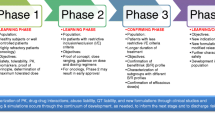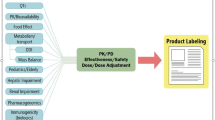Summary
The integration of pharmacokinetic and pharmacodynamic principles into drug development has been proposed as a way of making it more rational and efficient. The use of these principles in drug development to make scientific and strategic decisions is defined as the ‘pharmacokinetic-pharmacodynamic guided approach to drug development’.
The objectives of this survey were: (i) to assess the extent the pharmacokinetic-pharmacodynamic guided approach to drug development has been used in a large multinational pharmaceutical company: (ii) to evaluate the impact of pharmacokinetic and/or pharmacodynamic results on clinical drug development; and (iii) to identify factors which prevented the full application of the pharmacokinetic-pharmacodynamic guided approach.
This was done by looking at 18 projects in the current development portfolio at Hoffman La Roche and evaluating the use of this approach by interviewing the responsible clinical pharmacologist using a standardised questionnaire.
(i) Benefits from using the pharmacokinetic-pharmacodynamic guided approach were reported in every project, independent of development phase and therapeutic area. This approach was more extensively used in the recent projects. The selection of dosages in clinical studies was found to be the most important application of pharmacokinetic-pharmacodynamic results in terms of an impact on drug development, (ii) Time savings, up to several months, could be quantified in 8 projects during the entry-into-man studies and in 6 projects during the phase II or III studies. In 4 projects, 1 clinical study was avoided. (iii) The most important scientific factor preventing the full application of the approach was the lack of knowledge on the predictive value of the pharmacodynamic or surrogate marker for effect (6 projects).
The results of the survey have shown that the use of the pharmacokinetic-pharmacodynamic guided approach has contributed to making clinical drug development more rational and more efficient. Opportunities to apply the pharmacokinetic-pharmacodynamic approach should be identified in each project and a project specific strategy for the pharmacokinetic-pharmacodynamic guided approach should be defined during phase 0 of drug development.
Similar content being viewed by others
References
Peck CC, Barr WH, Benet LZ, et al. Opportunities for integration of pharmacokinetics, pharmacodynamics and toxicokinetics in rational drug development. Clin Pharmacol Ther 1992; 51: 465–73
Peck CC. Rationale for the effective use of pharmacokinetics and pharmacodynamics in early drug development. In: Yacobi A, Skelly JP, Shah VP, et al., editors. Integration of pharmacokinetics, pharmacodynamics and toxicokinetics in rational drug development. New York: Plenum Press, 1995: 1–5
Holford NHG, Peck CC. Population pharmacodynamics and drug development. In: van Boxtel CJ, Holford NHG, Danhof M, editors. The in vivo study of drug action. New York: Elsevier Science, 1992: 401–13
Campbell DB. The use of kinetic-dynamic interactions in the evaluation of drugs. Psychopharmacology 1991; 100: 438–50
Sale ME, Blaschke TF. Incorporating pharmacokinetic/pharmacodynamic modeling in drug development: are we ready? Drug Inf J 1992; 26: 119–24
International Conference on Harmonization. Harmonized tripartite guideline on dose response information to support drug registration. Geneva: ICH Secretariat, 1995
Holford NHG. The target concentration approach to clinical drug development. Clin Pharmacokinet 1995; 29: 287–91
Lemmens HJM, Dyck JB, Schafer SL, et al. Pharmacokineticpharmacodynamic modeling in drug development: application to the investigational opioid trefentanil. Clin Pharmacol Ther 1994; 56: 261–71
Steimer JL, Kawai S, Charnick S, et al. Physiological pharmacokinetic/pharmacodynamic (PB-PK/PD) models in drug development? In: Danhof M, Peck C, editors. Advances in simultaneous pharmacokinetic/pharmacodynamic modelling. Leiden: Leiden University, 1994: 42–7
Author information
Authors and Affiliations
Corresponding author
Rights and permissions
About this article
Cite this article
Reigner, B.G., Williams, P.E.O., Patel, I.H. et al. An Evaluation of the Integration of Pharmacokinetic and Pharmacodynamic Principles in Clinical Drug Development. Clin. Pharmacokinet. 33, 142–152 (1997). https://doi.org/10.2165/00003088-199733020-00005
Published:
Issue Date:
DOI: https://doi.org/10.2165/00003088-199733020-00005




